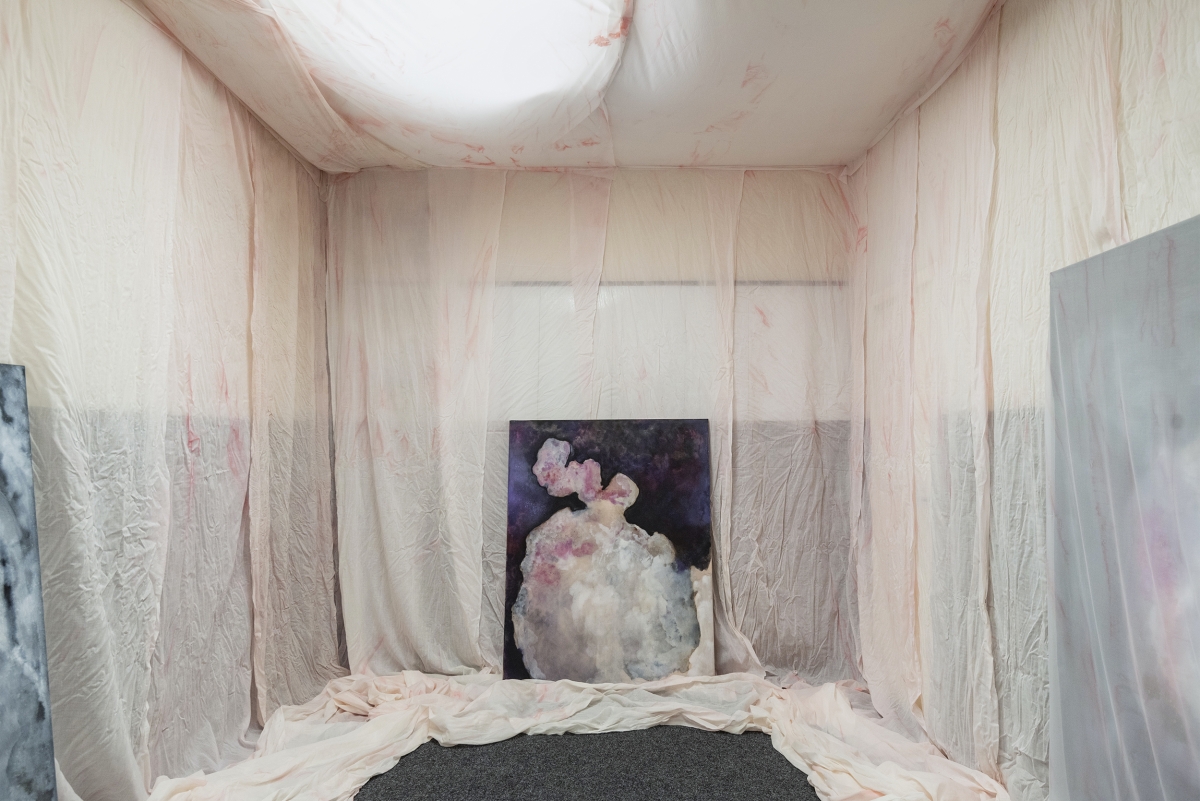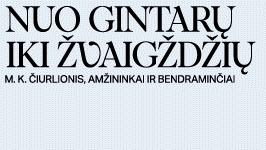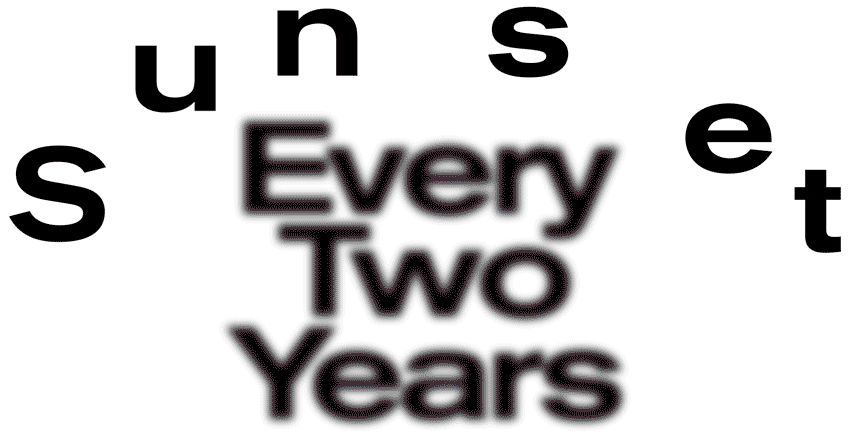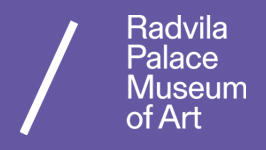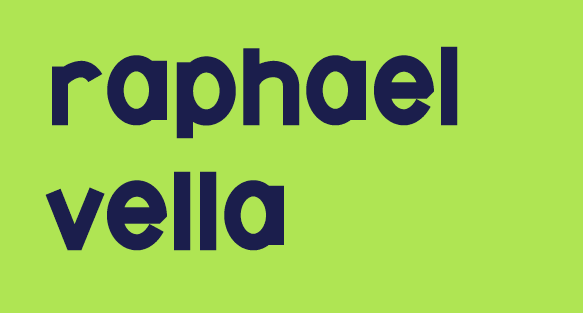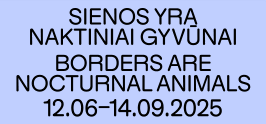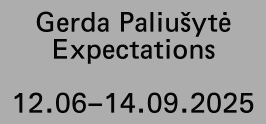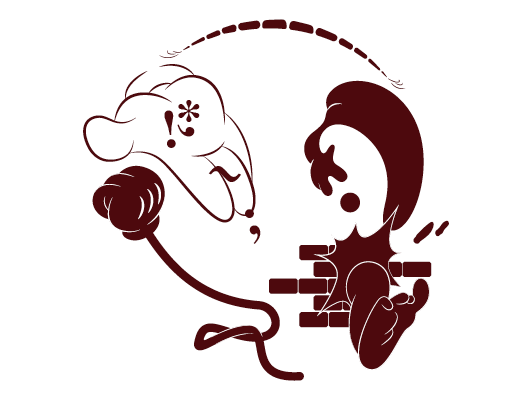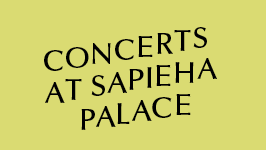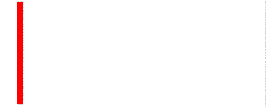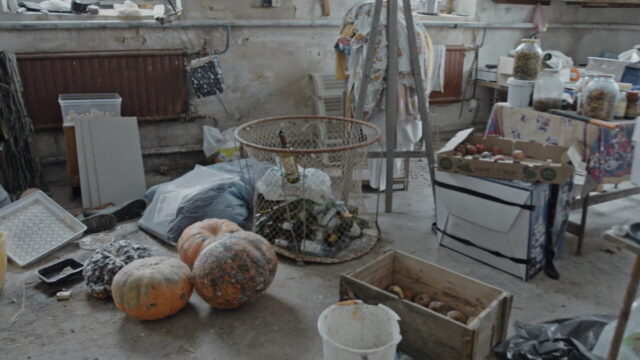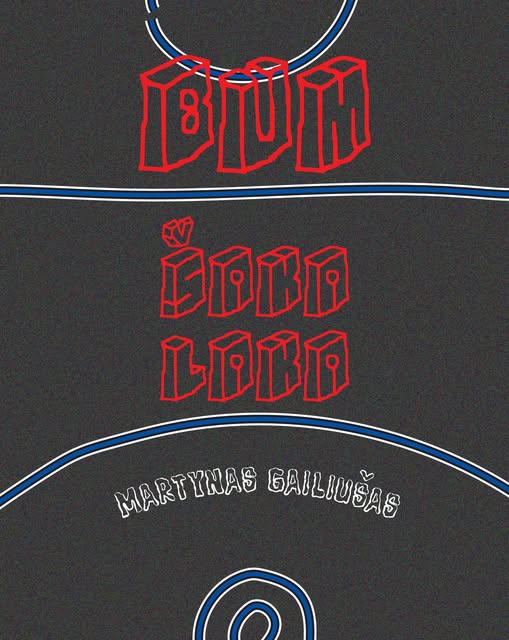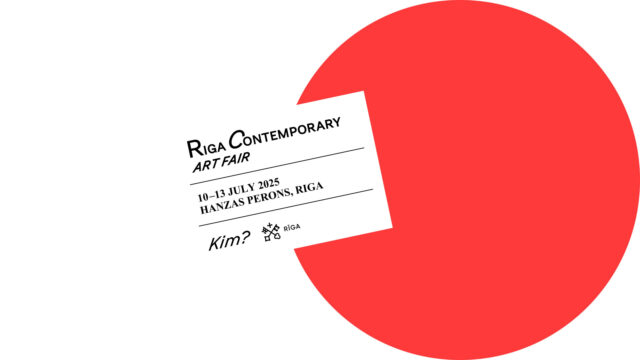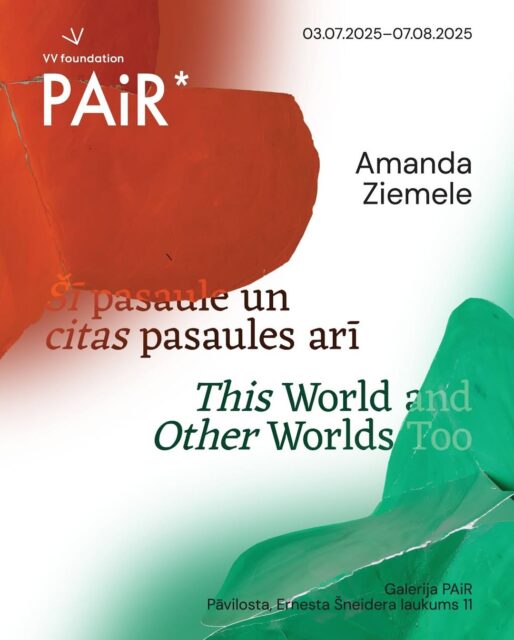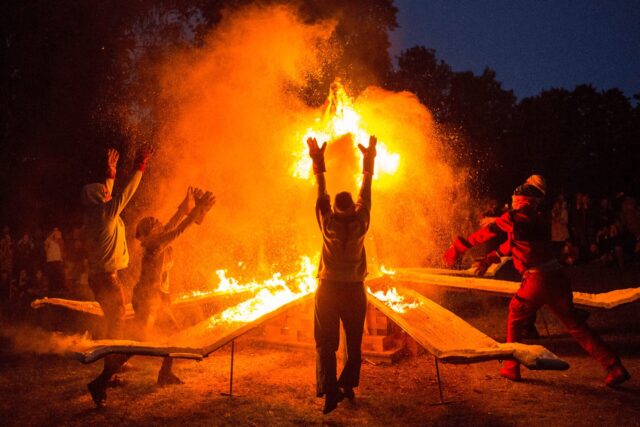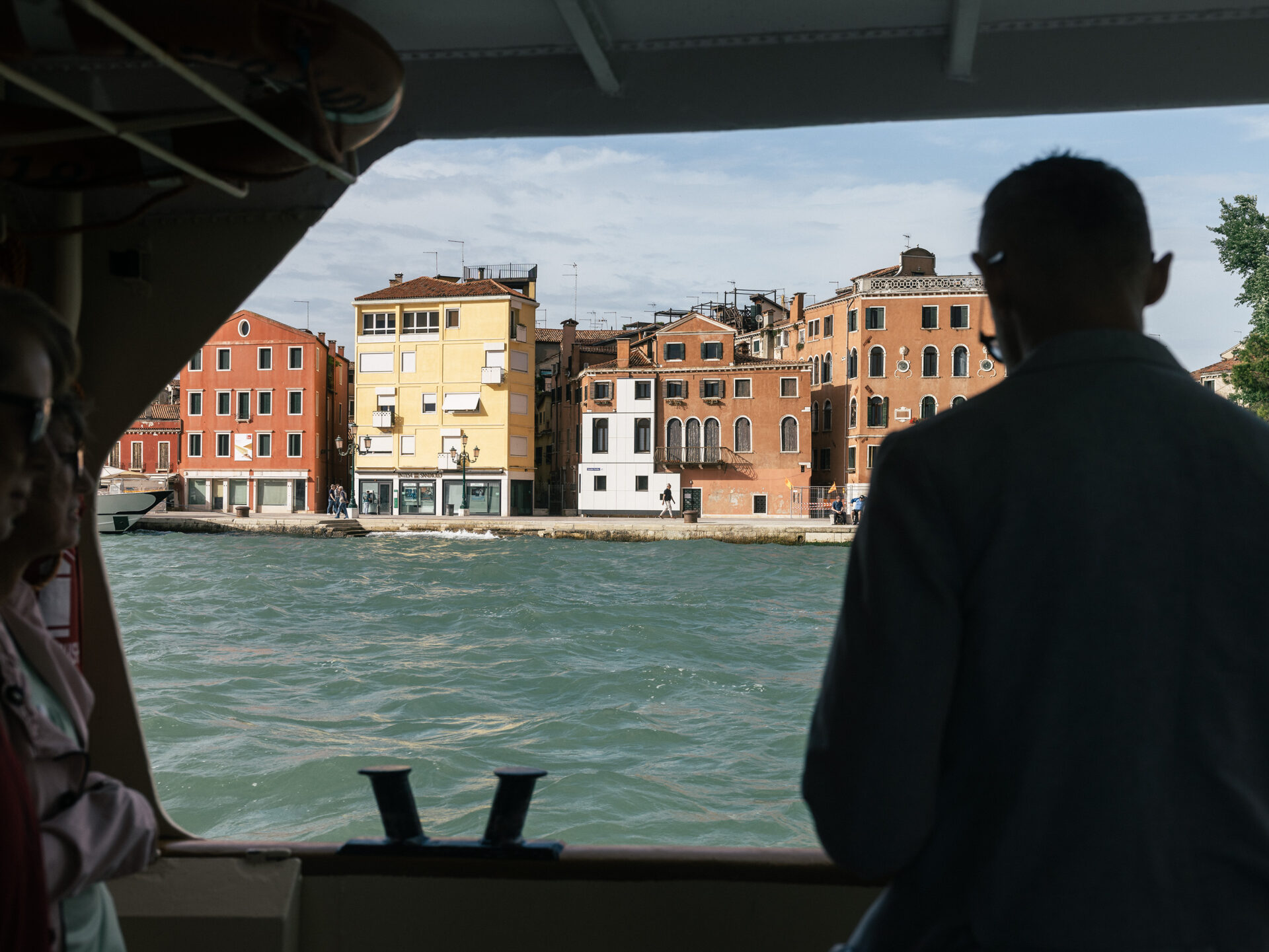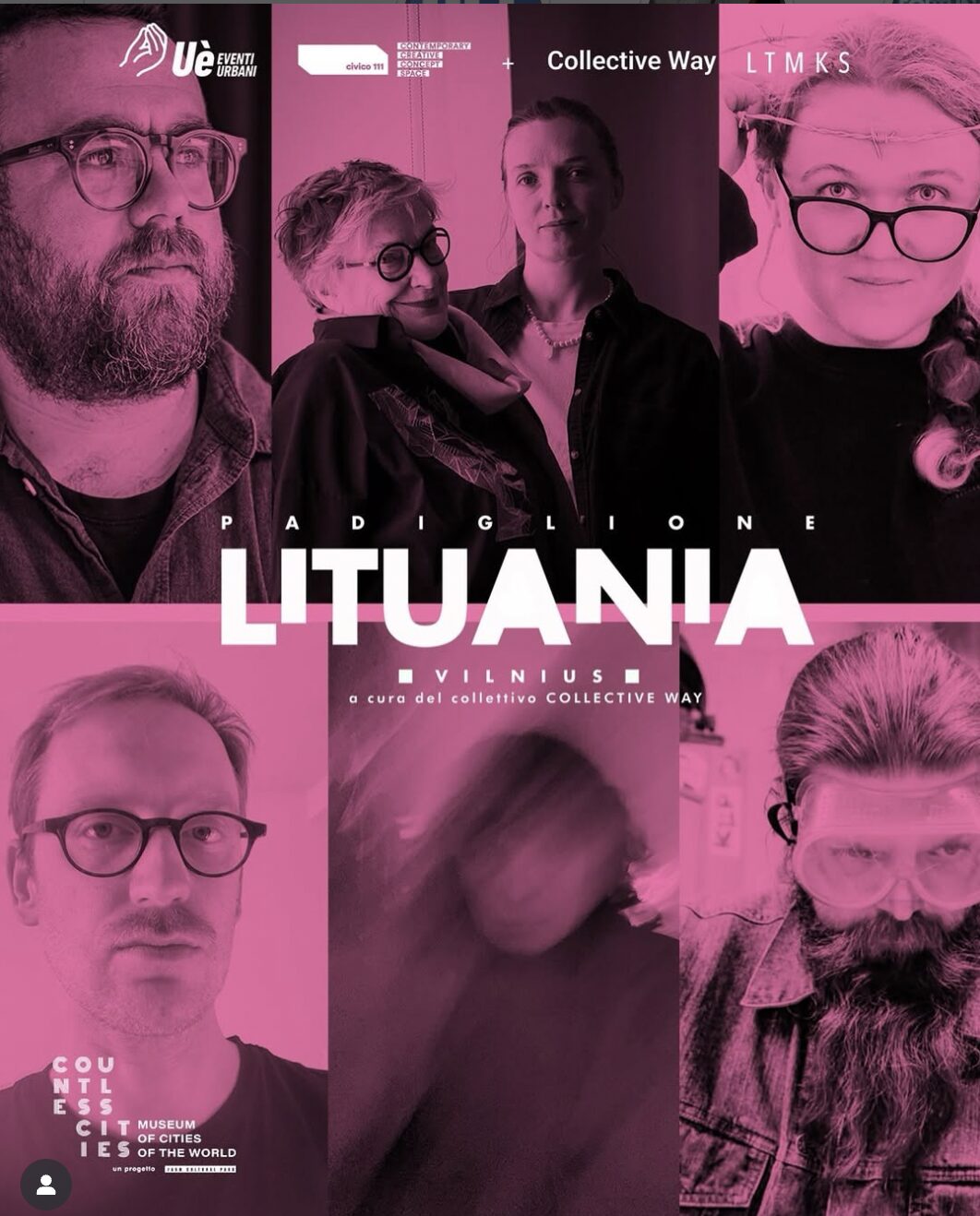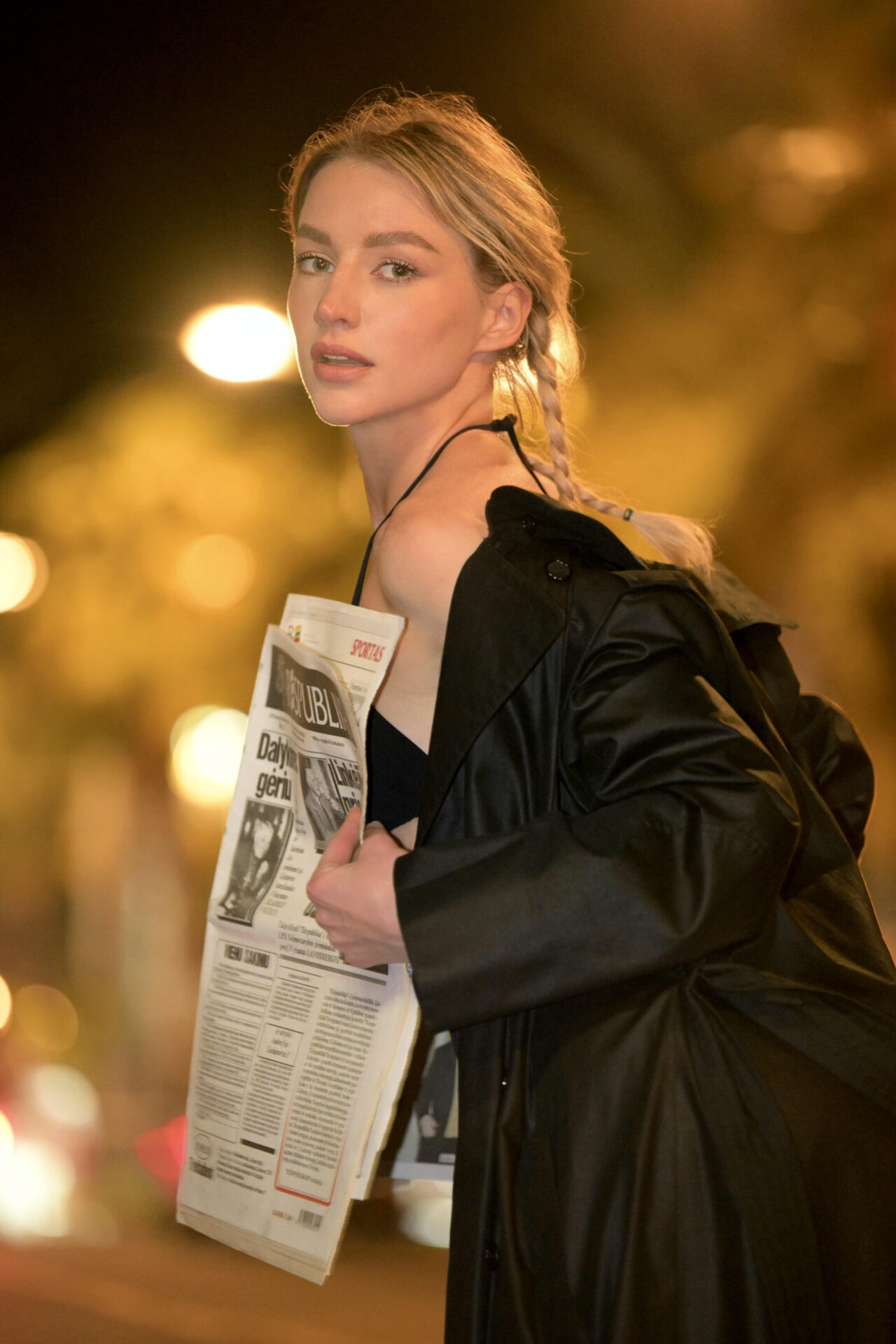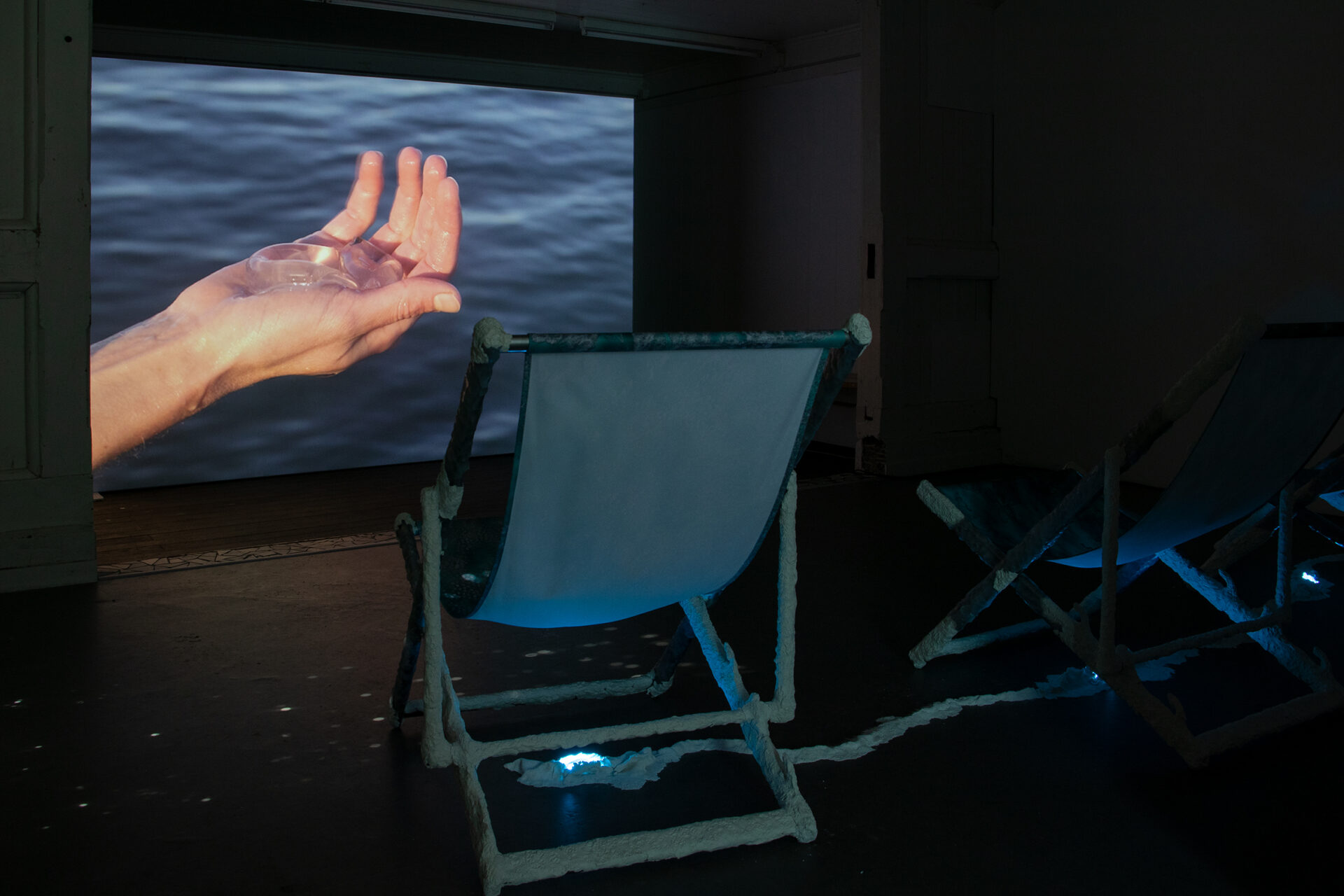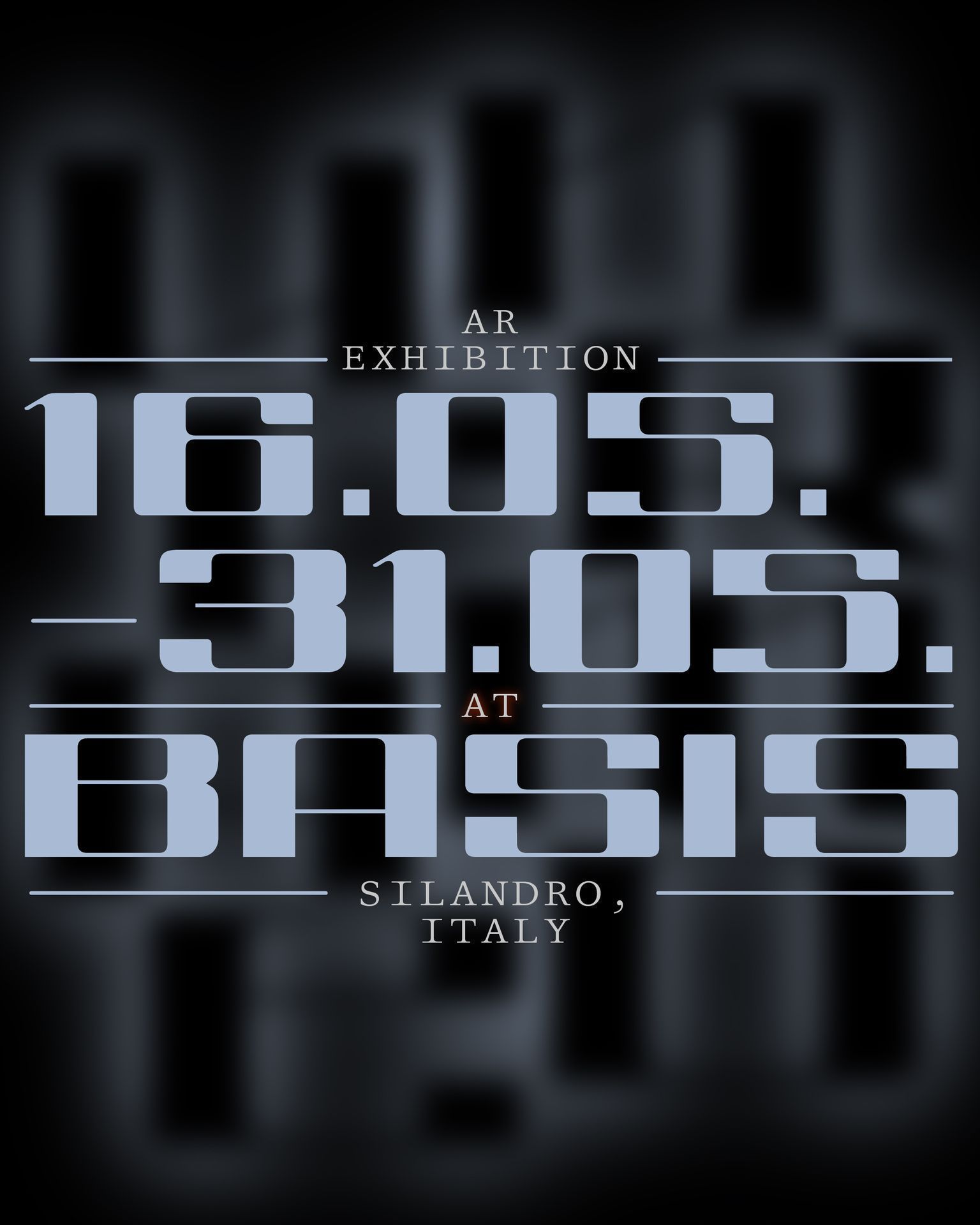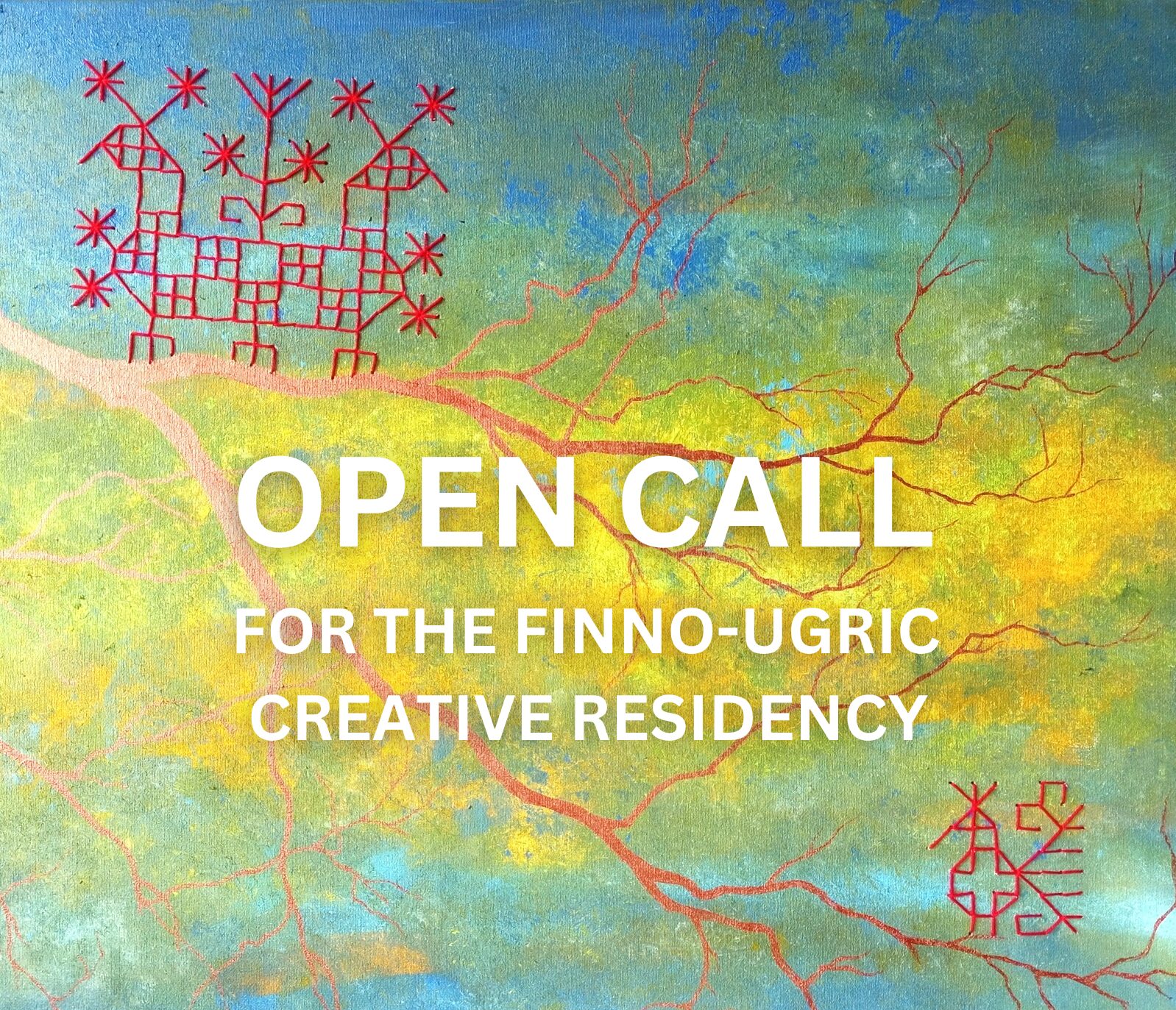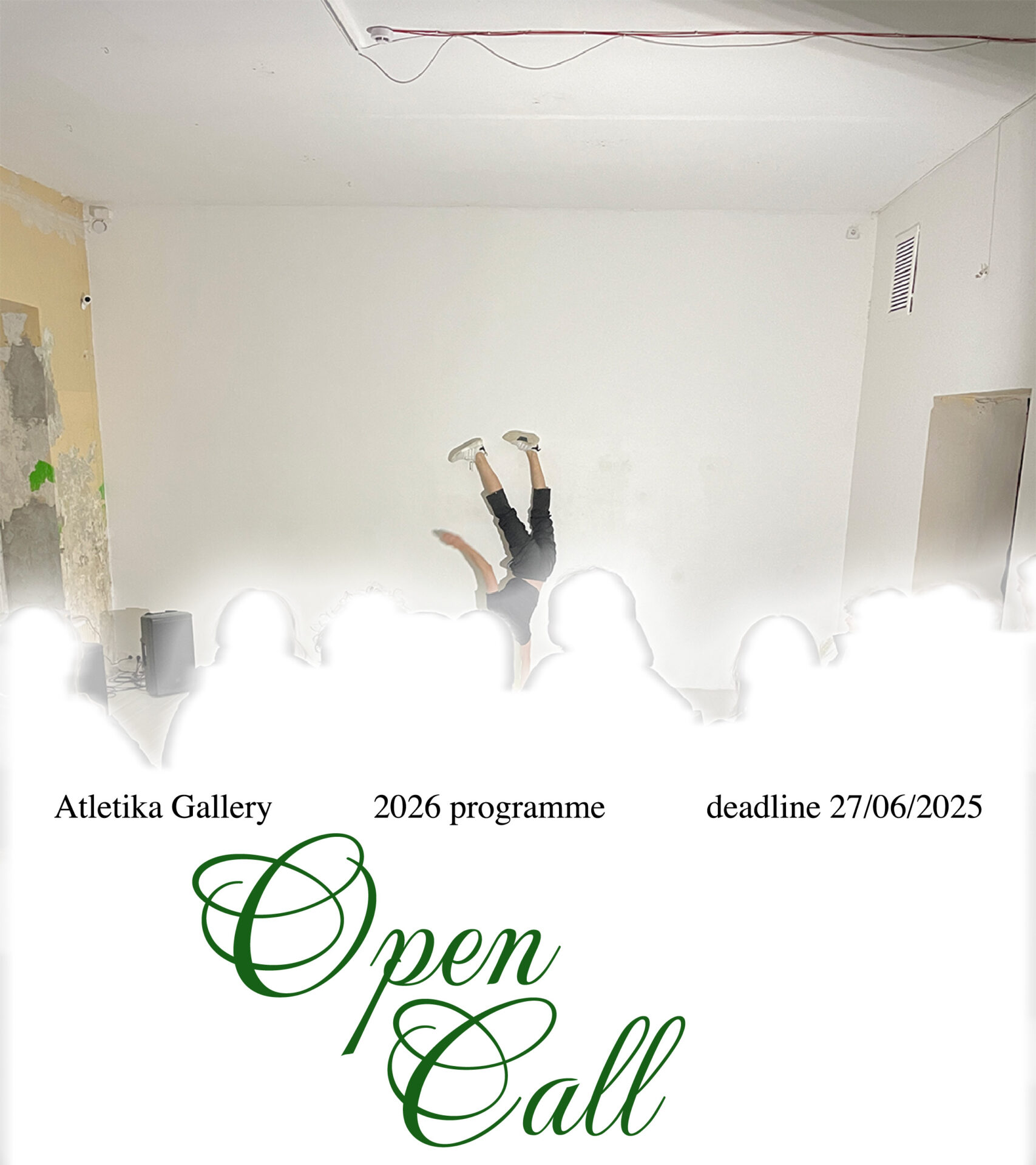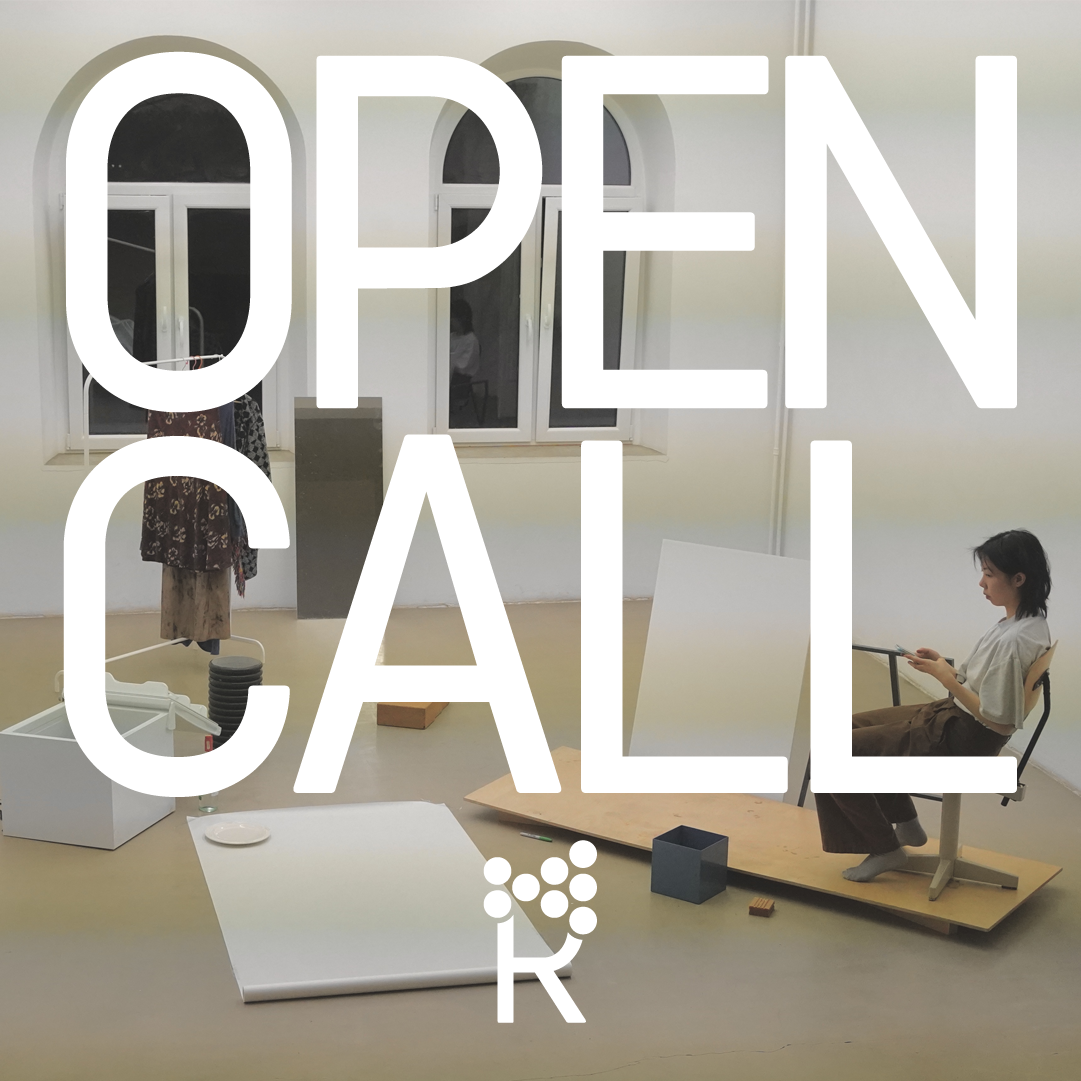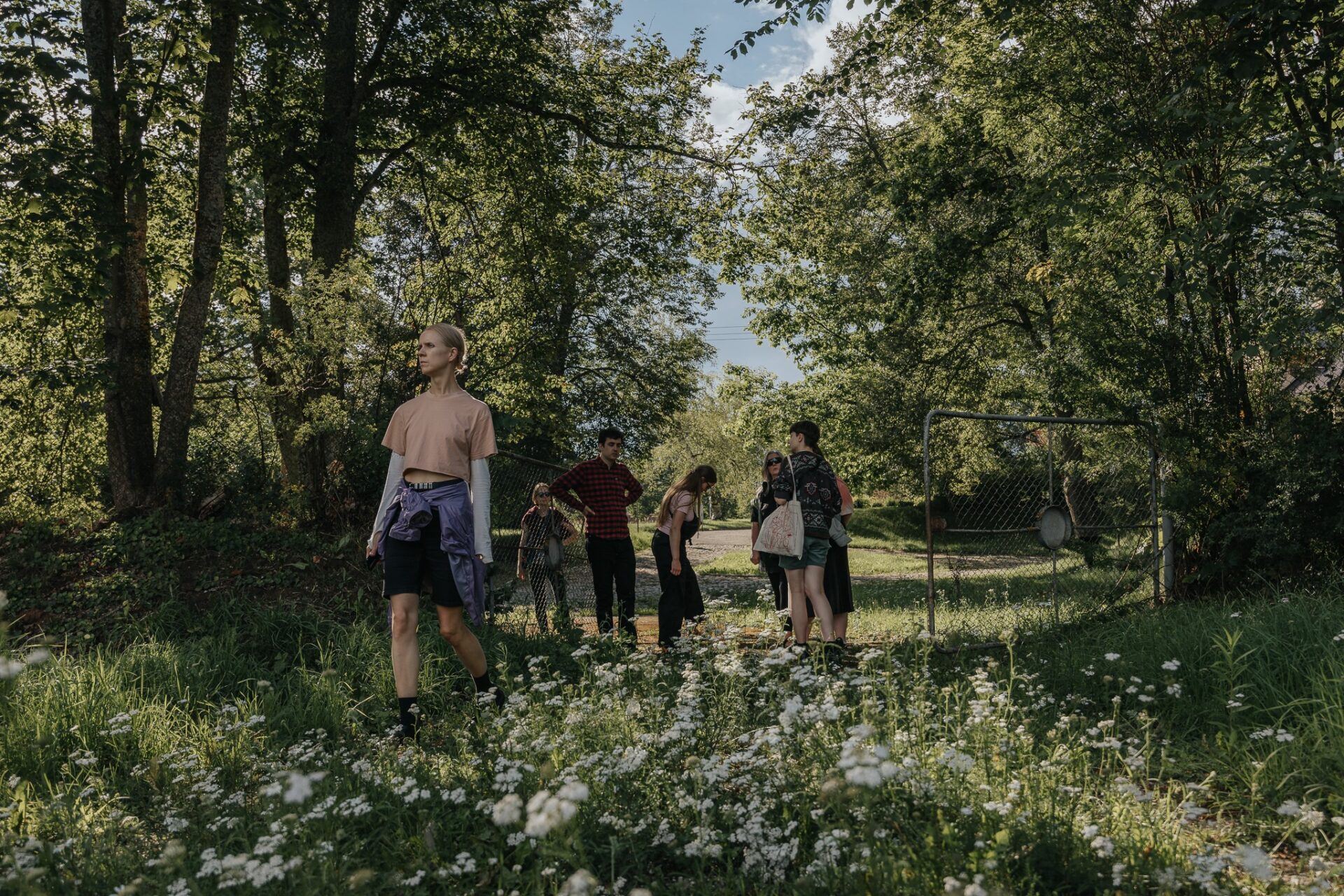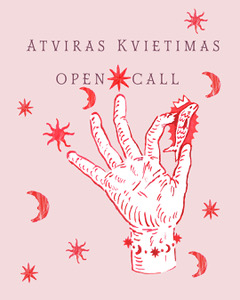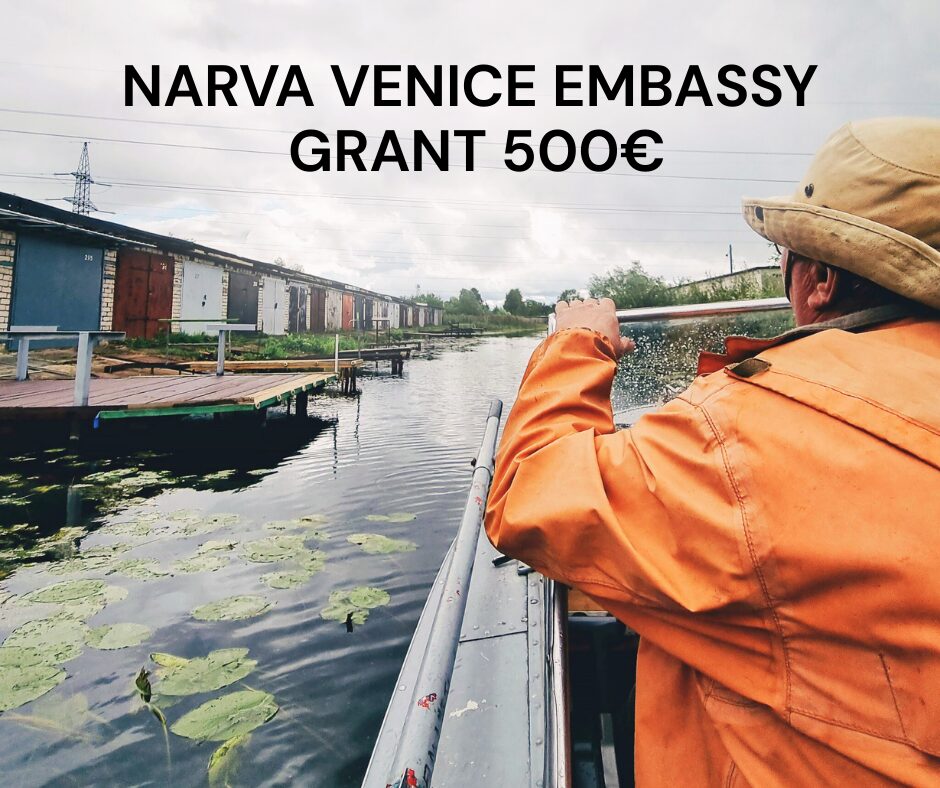Explaining the uncanny in one’s own words seems like a task for Sisyphus, especially considering how consistently the three curators/artists Artūras Mitinas, Monika Kornilova and Darius Jaruševičius operated on this sensation in their exhibition of the same title, held in September at the normally withering Palace of Culture, Entertainment and Sport (Vilnius), and in the exhibition catalogue. Nevertheless, to grasp better the sharp takes of this exhibition, one feels the need to dive deep into the origins of the sensation and the reasons behind it, and to realise how the topic unfolds through the contemporary art pieces presented.
When formulating the concept of the exhibition, the curators started with Sigmund Freud’s Das Unheimliche[1] which, in simplified terms, states that the uncanny is a state of doubting something very familiar, a long-known thing, phenomenon, object or environment, etc. For instance, our imagination can sometimes interpret an inanimate object, such as a doll, as having the possibility to be alive and conscious, and even to embody evil. According to Freud, our subconscious gets confused because of a suppressed practice, the childhood habit of playing with inanimate objects as though they were real. For example, we used to ‘feed’ dolls, chat to them, or lull them to sleep[2]. Meanwhile, by the time we have grown up, we have suppressed this kind of behaviour, because we have transferred it to our children, and have forgotten that we used to play with objects in the same way.
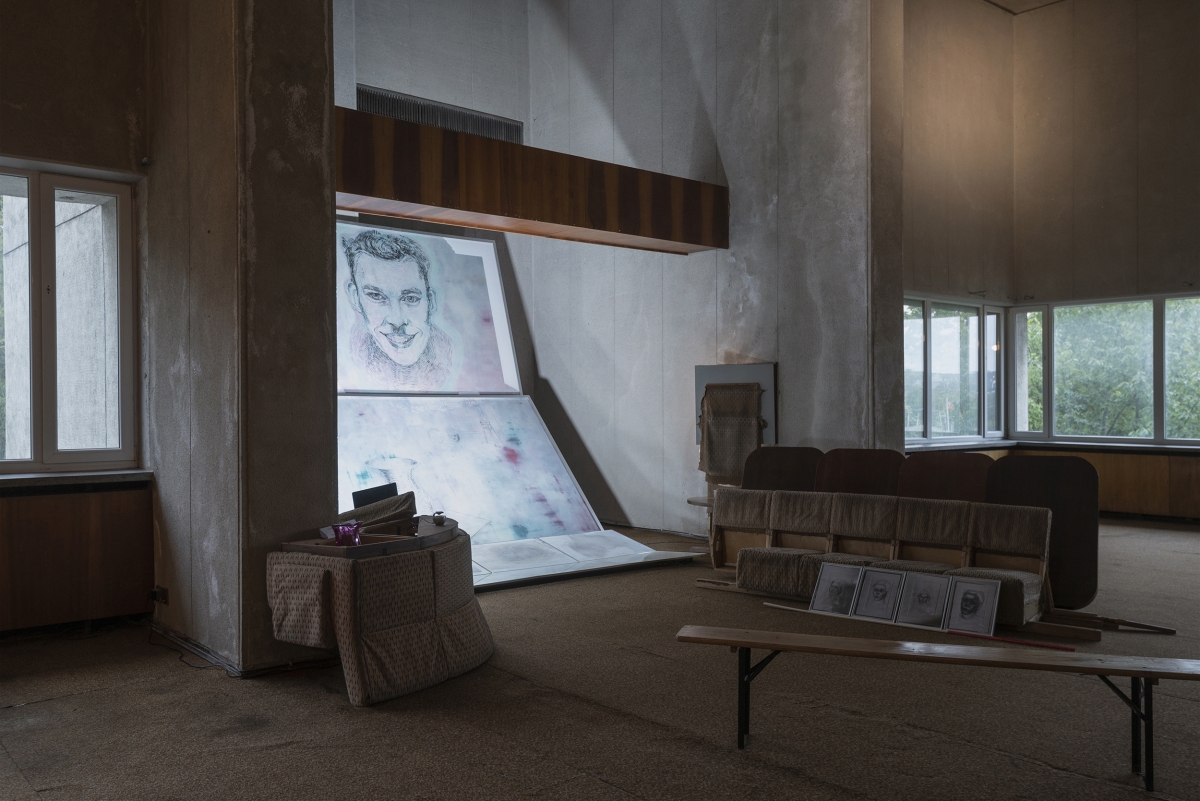 Alternatively, the uncanny can immerse one in an uncertain reality, when we feel afraid of losing something of ours because the environment, or part of it, suggests danger to our imagination. It could be a painfully familiar place, towards which, because of our experience or certain acquired information, we begin to feel a sense of distrust or anxiety, as though someone is about to threaten our bodies or our well-being, either physically or mentally. It could be a street that we run across every day, transforming into something uncanny in the twilight hours: it looks like trouble might be lurking just around the corner, an armed robbery perhaps, or rape, or something else, even if there is no evidence of real danger, not even a single shadow that could suggest it. The imagination itself creates it.
Alternatively, the uncanny can immerse one in an uncertain reality, when we feel afraid of losing something of ours because the environment, or part of it, suggests danger to our imagination. It could be a painfully familiar place, towards which, because of our experience or certain acquired information, we begin to feel a sense of distrust or anxiety, as though someone is about to threaten our bodies or our well-being, either physically or mentally. It could be a street that we run across every day, transforming into something uncanny in the twilight hours: it looks like trouble might be lurking just around the corner, an armed robbery perhaps, or rape, or something else, even if there is no evidence of real danger, not even a single shadow that could suggest it. The imagination itself creates it.
Examples should not be limited to how the uncanny is caused from an outside perspective. Freud said that this feeling can be caused by someone doubting their very self as an autonomous and unique unit. In other words, we can feel uncanny seeing our ‘doppelgänger’ or a repetition of our image which we do not immediately identify as our own. For example, when we notice ourselves caught on a reflective surface or in a photograph depicting a moment we do not recall participating in, we feel uncanny, as though we were looking into another dimension. Once, as I was ‘collecting’ footsteps to reach a goal I had missed that day, walking around my empty flat and scrolling on my phone, I miscalculated the trajectory between the corridor and the doorway, and ‘walked into’ the mirror on my wall closet. It reflected my face lit from below, and for a moment I was terrified, as though I had seen an image of someone alien to me, someone I did not know. In other words, my momentary fright had no basis in reality. However, for a fraction of a second I doubted I was alone in my room.
Finally, in Freud’s theory, the uncanny is linked to an inadvertent recurrence of some trivial detail which thus begins to be suspected as having a crucial meaning. By endowing a phenomenon or an object with a particular meaning, we imagine it wants to ‘communicate’ with us, warn us, or reveal something to us. Therefore, a specific element begins to cause terrible reactions, since, again, an inanimate object has ‘acquired’ social abilities. In Das Unheimliche, Freud illustrates recurrence with an example of how a formerly irrelevant number can become significant when we notice it and continue noticing it everywhere: it becomes a potential reference to a particular time[3]. Or when a random thought or a bad wish for someone comes true, we feel as if we have cast a spell.
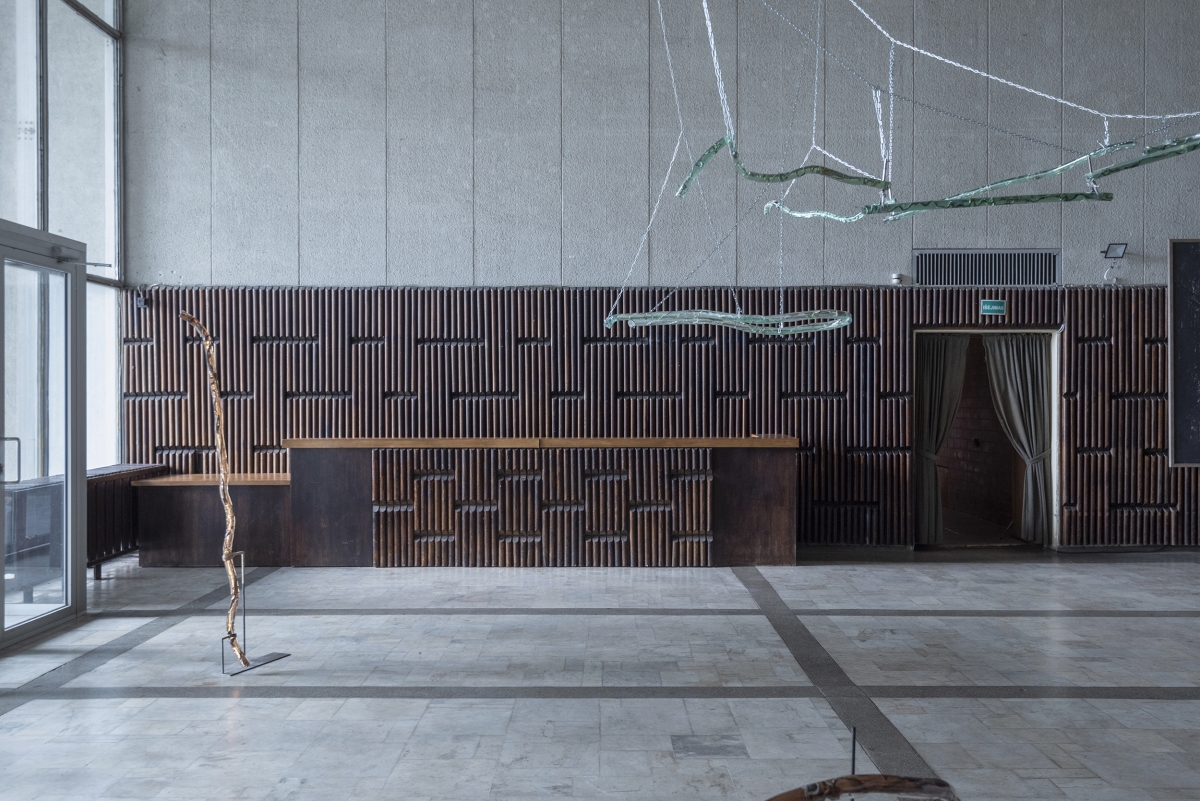 Nevertheless, the curators of ‘The Uncanny’ do not limit the sense within the confines of psychoanalysis. In the exhibition catalogue, the curators’ approach to Freud’s theory is critical: they cite the cultural theoretician Mark Fisher, who says that the very sensation of the uncanny was left unexamined by the father of psychoanalysis in his own writing. It seems that in order to handle this topic, the curator trio retrospectively present the practical application of the sensation in question in the field of visual art. They show what concepts (usually contradictory ones) the Surrealists and later the American artist Mike Kelley (1954-2012) used to liberate the expression of the uncanny; the latter artist worked on a project in which he ‘stressed the opposition between materiality, colour, scale, scent, and other sensory characteristics and fantasies or mental projections’[4]. By researching the uncanny, Mitinas, Kornilova and Jaruševičius have not only formed an elaborate theoretical ballast, but also gathered a collection of works by 15 contemporary artists from Lithuania and abroad, which helped them express their interpretation of the sensation in question.
Nevertheless, the curators of ‘The Uncanny’ do not limit the sense within the confines of psychoanalysis. In the exhibition catalogue, the curators’ approach to Freud’s theory is critical: they cite the cultural theoretician Mark Fisher, who says that the very sensation of the uncanny was left unexamined by the father of psychoanalysis in his own writing. It seems that in order to handle this topic, the curator trio retrospectively present the practical application of the sensation in question in the field of visual art. They show what concepts (usually contradictory ones) the Surrealists and later the American artist Mike Kelley (1954-2012) used to liberate the expression of the uncanny; the latter artist worked on a project in which he ‘stressed the opposition between materiality, colour, scale, scent, and other sensory characteristics and fantasies or mental projections’[4]. By researching the uncanny, Mitinas, Kornilova and Jaruševičius have not only formed an elaborate theoretical ballast, but also gathered a collection of works by 15 contemporary artists from Lithuania and abroad, which helped them express their interpretation of the sensation in question.
The exhibition greets visitors as soon as they enter the lobby of the Palace of Culture, Entertainment and Sport. The exhibits seem to be integrated into the interior: they form a dialogue that continues throughout the other spaces. This ‘conversation’ is rather paradoxical, especially bearing in mind that the building was not designed for exhibitions; nevertheless, the curators managed to create a sense of continuity. It begins right as you step into the Palace of Culture, Entertainment and Sport: at first, one encounters a staircase and an old relic of the building, a huge brass chandelier with coloured glass (1982)[5] hanging right over it. Likely, it was originally designed to counteract the cold and dark interior of the building with warm amber tones. Once the eye gets accustomed to this sight (even though unlit), the materiality of the chandelier responds to the Paris-based artist Laura Gozlan’s installation No Spares, No Soul (2018), objects made from organic glass mixed with other elements. Following a rather classic script, one sees her piece as something instantly uncanny, since you can’t immediately ‘read’ the artwork of the still-unknown contemporary artist. Although the structure and the scale of the installation are intriguing, it remains ungraspable, at least without additional tools, namely, the catalogue with its description, or the exhibition guide. Only after hearing Jaruševičius’ story and reading the curators’ text did I learn that the artist’s work was inspired by the story of ‘Adrian of Nicomedia, a pagan army officer in the Roman Empire, who was astounded by the strength of Christians, accepted their faith, and was then tortured to death but saved’[6]. It then reveals how the glass structures hanging from the ceiling by metal chains refer to the intestines ‘full of sediment’ that were taken from the body of the protagonist, and which thus acquire a symbolic meaning of torment. From the viewer’s perspective, the latter can be linked to both one’s physical and psychological state, which is particularly characteristic of those prone to maximalism, when either our environment or our very selves demand exceptional results. We might be talking about the burn-out phenomenon, when we take on more than we can handle, or when chasing titanic goals we multiply ourselves into different characters who have to adapt to different situations, all of which subconsciously harm us through constant or chronic stress. And it affects us physically, through our tense muscles, disorganised breathing patterns or internal organ activity, or insomnia; as well as psychologically, since we find ourselves irrationally outraged, hostile, anxious, sad, disappointed, or even depressed. We might also talk about the slightly worn-out issue of the influence social media have on us: we aim to live up to the standards of those with great numbers of followers, and we deem them applicable and even compulsory like ‘religious’ dogma. We exhaust ourselves financially, physically, psychologically, and in all other ways. Considering the situation towards which Gozlan’s work guides us, it might start to feel uneasy how we humans, made up of flesh, bones and emotional intellect, attempt to become ‘robots’ that make no errors and comply with the ‘manufacturers’ specifications’ required by the market or society.
There is a second installation by Laura Gozlan, made of fragments of torso, like parts of an autopsied corpse, attached to a banister-like construction located deep under the lobby staircase. Observing these anthropomorphic elements, I begin to think how dissonant the human outlook on life is, especially regarding different species. The ribs, breast, cooled liver, hearts, and other organs seen in the meat sections at supermarkets do not surprise us, even though they were once parts of conscious beings: we buy them, touch them, marinate them, cut them up or flip them over in the frying pan. And yet to flinch, belch or otherwise express our disapproval of killing, we only need to read a crime description, in black ink on white paper, of a dissected human body. We do not even need to turn to Netflix villains, the romanticised Ted Bundies and Jeffrey Dahmers, who distort actual images of dreadful people: there have been serial killers in Lithuania’s criminal history too. The tour guides in Lukiškės Prison tell about a case of cannibalism. In 1982, Ignacas Montvydas cold-bloodedly slit his wife’s throat, cut out her stomach, cut off her breasts, and fed her nipples to dogs. After 11 years in jail, when he came back to society, Montvydas slaughtered another woman (with whom he had been drinking), cut off her shins and thighs, and dismembered her arms.
The exhibition’s integration into the interior of the building continues with three dark drawings, as though ‘cast’ into the dark oak walls of the lobby. They are parts of Ian Damerell’s triptych Saligia. The large-scale charcoal drawings, architectonic in their structure, portray anthropomorphic bodies falling upside-down. This image relates to the symbolic depiction of the fall of man, which is reinforced by the title, an acronym in Latin for the seven deadly Christian sins[7]. Innately dark and grim works speak of some demonic power or the dark side. Therefore, the drawings suggest reconsidering humans as dual creatures, existing between good and evil, or reality and mysticism.
Climbing the lobby stairs, one reaches Tauras Kensminas’ concrete sculpture Throbbing (Tvinkstantis, 2020), camouflaged as a part of the stairway structure, leaning menacingly towards the viewer. It seems it is ready to slip down with the force of a landslide and bury everything in its path. If not bury, then crush, break or level. The effect of this potential becomes even more convincing as one approaches the artwork and sees the red strands, flowing like blood from a body buried under it. The artwork is described in the catalogue as an abstract object with an unknown purpose. However, because of its cold materiality and monumental scale, both of which imply a heavy weight and a corresponding destructive and depressing force, the sculpture reminds me of a gravestone. It is just that cemetery headstones are usually smooth, or they have a symmetrical composition of geometrical elements (like tiles or bricks), whereas this sculpture, inversely, is protuberant, the forms resemble a process of seething frozen in action, boiling water bubbles captured just before bursting. Kensminas juxtaposes vitality and stagnation, and in this way constructs a contradiction: is the object dead or alive?
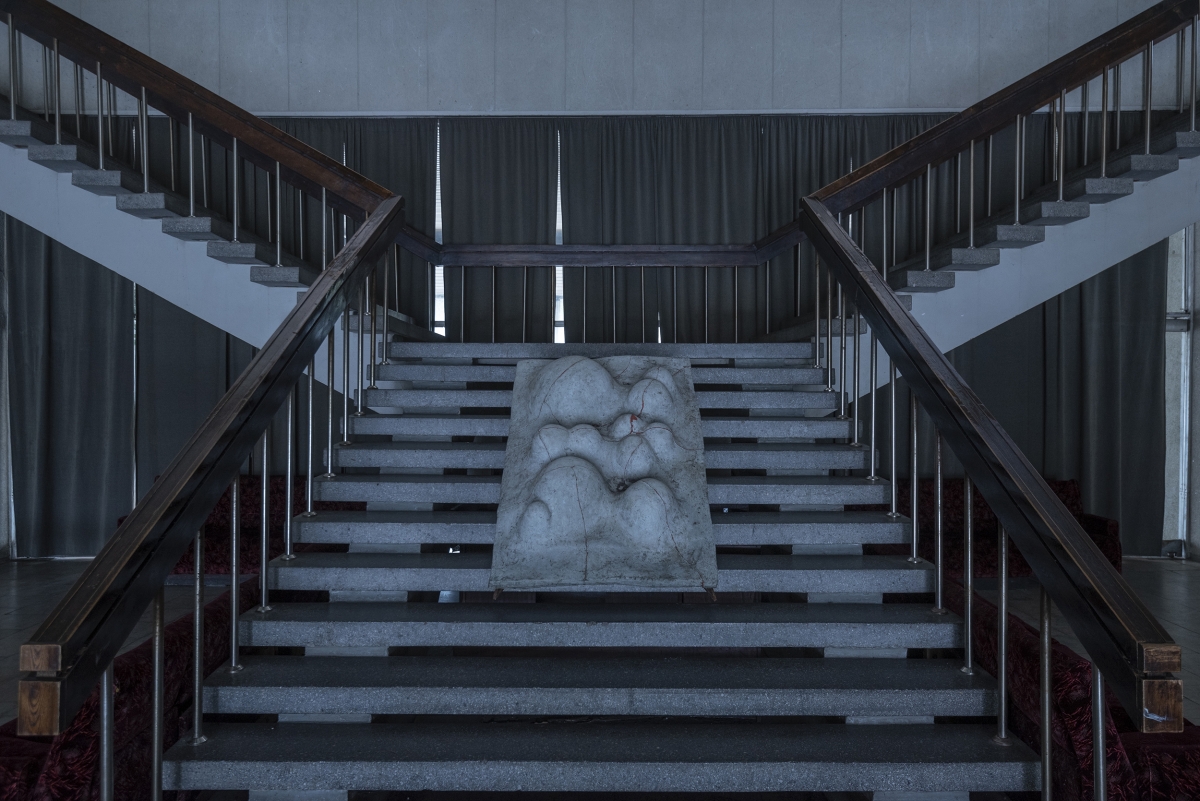 At the stairs, the route branches out: the visitor can either go further upstairs, or turn left or right. Walking around Algimantas Mačiulis’ brutal Modernist building in my mind, I choose the path ‘on the right’. The exhibition curators put most artists, in larger or smaller groups, in shared spaces; however, Auksė Miliukaitė gets her own space, the former café of the Palace of Culture, Entertainment and Sport, where she has set up her site-specific installation Growling Tummy (Urzgiantis pilvukas, 2021-2022). Other artists’ works are linked to their environment in terms of aesthetics, whereas Miliukaitė chooses to employ the functionality of the former space. The visitor encounters the artist’s felt objects, textiles stretching down to the floor, made of various types of hair, fur and wool (from dogs, sheep and humans), in the dimly lit space, which also presents the Balčikonis family’s batik frieze Pavakarys (Dinner, 1982) set up on the upper section of the dark oak walls. Although the artist has also put a scent vaporiser and set up a table with wine glasses and fruit, which take on the role of a still-life, and signify temporality, decaying and naturally decomposing bodies, I was interested mostly in her textile work. On one hand, their materiality is redolent of worn-out carpets, which, if they were able to speak, could say everything they have witnessed: how they have been dragged across the floor, scraping splinters of parquet or protruding nails; how they were gnawed by starving wild animals which had managed to sneak into the abandoned building in search of a shelter; how they soaked up all the sticky and shiny liquids, the secretions of bodies overcome by primal sexual instincts. Here, the uncanniness should be caused not by the events described but by the talking carpets. I believe things undoubtedly have a memory, it is just a different kind to what we are used to understanding. How else could we trace back the marks left on them in relation to other elements, trying to make sense of the order of events from the present to the past? For instance, when we notice washed-out dunes, we learn that the sea level has risen above the level of the beach. In Miliukaitė’s installation, we can sense different dimensions crashing into each other: this is strengthened by the original café mirror, which reflects reality and acts as a heterotopia. Here, the reflections of objects take up a space which is not there physically, they are on the threshold between reality and fantasy. On the other hand, apart from the initial visual reference, Miliukaitė’s installation’s title, a growling tummy, signifies the (human) body. Felt objects seem to be imitating internal organs that are always inside us and yet on rare occasions can be observed and not by every eye. At times the pink objects, pink as flesh, resemble collapsed internal organs, or, considering the title, stomachs. Autopsied, taken from the body, and thrown on to the ground, they begin to go grey because of the halted blood flow, or perhaps they had begun going grey earlier, when still inside the body, from all the pollution of fast food and coffee on an empty stomach. However, going inside the human body (a body to which we do not relate unless we see it) is not at all necessary; it is enough to consider human hair, used in the artist’s work, to realise how we marvel at or stroke it when it is attached to our bodies, and yet when it gets detached from the organism, when it falls or breaks off and slides down the bathroom pipes together with streams of soapy water, we regard it as disgusting and horrible, especially if we end up having to pull the hair out of the pipe.
At the stairs, the route branches out: the visitor can either go further upstairs, or turn left or right. Walking around Algimantas Mačiulis’ brutal Modernist building in my mind, I choose the path ‘on the right’. The exhibition curators put most artists, in larger or smaller groups, in shared spaces; however, Auksė Miliukaitė gets her own space, the former café of the Palace of Culture, Entertainment and Sport, where she has set up her site-specific installation Growling Tummy (Urzgiantis pilvukas, 2021-2022). Other artists’ works are linked to their environment in terms of aesthetics, whereas Miliukaitė chooses to employ the functionality of the former space. The visitor encounters the artist’s felt objects, textiles stretching down to the floor, made of various types of hair, fur and wool (from dogs, sheep and humans), in the dimly lit space, which also presents the Balčikonis family’s batik frieze Pavakarys (Dinner, 1982) set up on the upper section of the dark oak walls. Although the artist has also put a scent vaporiser and set up a table with wine glasses and fruit, which take on the role of a still-life, and signify temporality, decaying and naturally decomposing bodies, I was interested mostly in her textile work. On one hand, their materiality is redolent of worn-out carpets, which, if they were able to speak, could say everything they have witnessed: how they have been dragged across the floor, scraping splinters of parquet or protruding nails; how they were gnawed by starving wild animals which had managed to sneak into the abandoned building in search of a shelter; how they soaked up all the sticky and shiny liquids, the secretions of bodies overcome by primal sexual instincts. Here, the uncanniness should be caused not by the events described but by the talking carpets. I believe things undoubtedly have a memory, it is just a different kind to what we are used to understanding. How else could we trace back the marks left on them in relation to other elements, trying to make sense of the order of events from the present to the past? For instance, when we notice washed-out dunes, we learn that the sea level has risen above the level of the beach. In Miliukaitė’s installation, we can sense different dimensions crashing into each other: this is strengthened by the original café mirror, which reflects reality and acts as a heterotopia. Here, the reflections of objects take up a space which is not there physically, they are on the threshold between reality and fantasy. On the other hand, apart from the initial visual reference, Miliukaitė’s installation’s title, a growling tummy, signifies the (human) body. Felt objects seem to be imitating internal organs that are always inside us and yet on rare occasions can be observed and not by every eye. At times the pink objects, pink as flesh, resemble collapsed internal organs, or, considering the title, stomachs. Autopsied, taken from the body, and thrown on to the ground, they begin to go grey because of the halted blood flow, or perhaps they had begun going grey earlier, when still inside the body, from all the pollution of fast food and coffee on an empty stomach. However, going inside the human body (a body to which we do not relate unless we see it) is not at all necessary; it is enough to consider human hair, used in the artist’s work, to realise how we marvel at or stroke it when it is attached to our bodies, and yet when it gets detached from the organism, when it falls or breaks off and slides down the bathroom pipes together with streams of soapy water, we regard it as disgusting and horrible, especially if we end up having to pull the hair out of the pipe.
The adjective used in the title of Miliukaitė’s work gives the object in question a particular mood and character. Growling is usually linked to rage and anger. It seems the installation does not refer to a pleasant tingling, the so-called butterflies in the stomach, a sensation that might actually be deceptively cruel, since it confuses and breaks a person’s identity through the conflicting powers of the rational ego and the instinctive id. Instead, it describes a stomach’s growl, able to humiliate or make its owner feel uncomfortable, even if the process itself is only natural.
All this can be said about the installation by Miliukaitė: an elaborate review of it (even in the context of a group exhibition) could be extended into a separate text. To add briefly, I would like to note that this piece continues in a tight space connected to the café, like appendicitis. If we consider the objects discussed earlier as pulled-out organs, it seems as if the visitors step inside the organs (which is reinforced by the artist’s textiles ‘growing’ on the walls). The viewer gets symbolically shrunk to the size of a bacteria, or some intervening foreign body, whose perspective changes the perception of scale. To me, it signifies the reconsideration of trifles, and in terms of geological time, of ourselves as beings. The sense of the uncanny is often hyperbolised in our minds as something catastrophic, while in reality it is completely bearable, beatable, and even forgettable.
Just like the cafe, the bar on the same floor of the building is dimly lit, and there is another Balčikonis family frieze, Paukščio skrydis (Flight of a Bird, 1982). The space seems to be dominated by the artist Monika Kornilova, with the single exception of a glazed ceramic sculpture placed on the bar by Adomas Danusevičius. The latter seems to be teasing the viewer with the interplay of art and illusion[8]: is this riddle/object a penis captured at a climactic moment, or a penis-shaped mushroom sticky from rain?
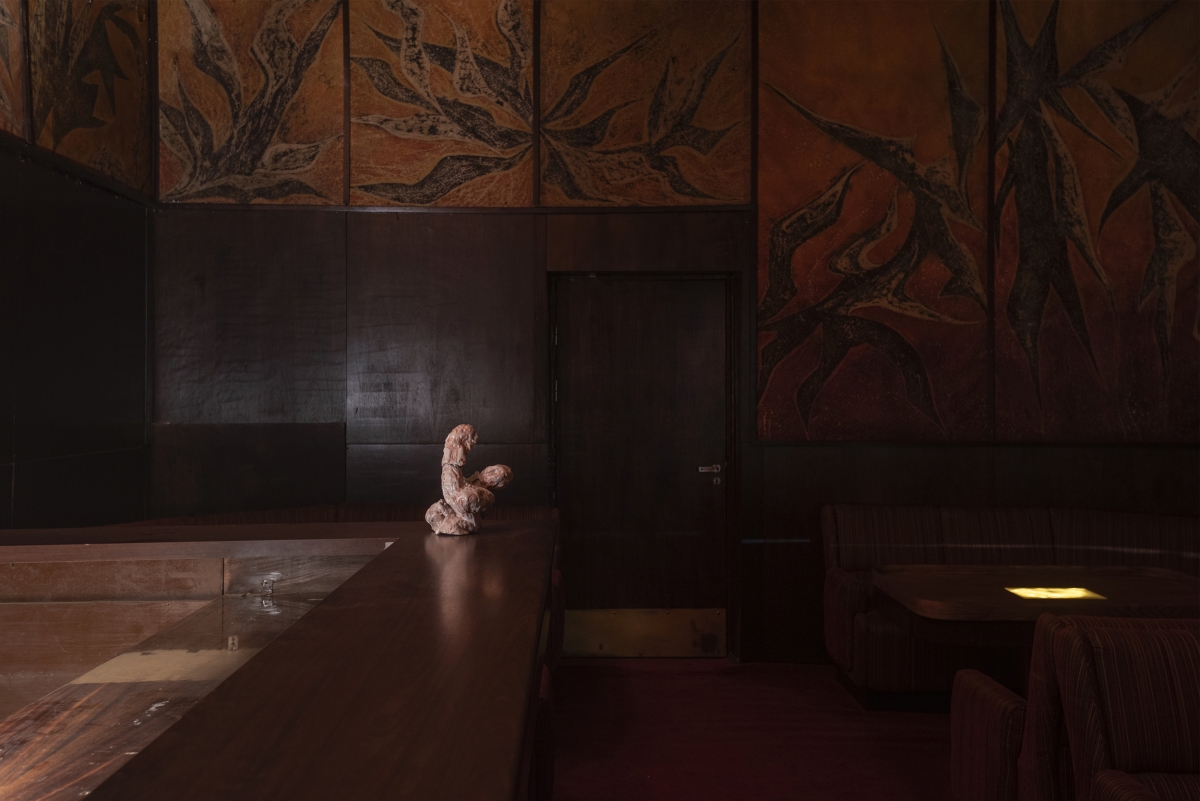 Stepping into the shadowy room, our eyes cling to the small luminescent sources of light coming from the tables. Where do we go when in an unknown space if not towards the light? Like a mosquito flying into a candle flame, I approached Kornilova’s object installation Sparneliai, grandinėlės, lelijos, rašalas (Little Wings, Chains, Lilies, Ink, 2022), created specifically for this exhibition. It should be mentioned that Kornilova takes on three different roles in this exhibition: curator, painter and graphic artist. There are a couple of faded, washed-out (technique-wise) portraits painted by Monika, hanging in the lobby, namely, A.M. and L.L. Their earthy colours fit into the oak walls as well as the works of Damerell, but the former did not hold my attention for so long. Hence, I was very glad to learn that the artist had chosen to show some other works of hers: the graphic work revealed the installation-related layer of her creative practice. I am talking about the carvings integrated into the bar tables and lit up from below: they depict compositions of details of sketched natural motifs, bits of still-lifes, and handwritten words. Visually, this installation reminds me of amber inclusions, the little trapped creatures, usually small flies, ticks or spiders. Looking at the little bodies, you wonder how they got trapped inside the hardening resin. I think, in a way, Kornilova captures and preserves the toils of thought which visitors, leaning over the tables, attempt to solve like their own, without taking note of the fact that they look like radiologists trying to decipher the sensations of others, perhaps some traces of boredom or frustration, caused by Kornilova’s drawings (if we believe the catalogue).
Stepping into the shadowy room, our eyes cling to the small luminescent sources of light coming from the tables. Where do we go when in an unknown space if not towards the light? Like a mosquito flying into a candle flame, I approached Kornilova’s object installation Sparneliai, grandinėlės, lelijos, rašalas (Little Wings, Chains, Lilies, Ink, 2022), created specifically for this exhibition. It should be mentioned that Kornilova takes on three different roles in this exhibition: curator, painter and graphic artist. There are a couple of faded, washed-out (technique-wise) portraits painted by Monika, hanging in the lobby, namely, A.M. and L.L. Their earthy colours fit into the oak walls as well as the works of Damerell, but the former did not hold my attention for so long. Hence, I was very glad to learn that the artist had chosen to show some other works of hers: the graphic work revealed the installation-related layer of her creative practice. I am talking about the carvings integrated into the bar tables and lit up from below: they depict compositions of details of sketched natural motifs, bits of still-lifes, and handwritten words. Visually, this installation reminds me of amber inclusions, the little trapped creatures, usually small flies, ticks or spiders. Looking at the little bodies, you wonder how they got trapped inside the hardening resin. I think, in a way, Kornilova captures and preserves the toils of thought which visitors, leaning over the tables, attempt to solve like their own, without taking note of the fact that they look like radiologists trying to decipher the sensations of others, perhaps some traces of boredom or frustration, caused by Kornilova’s drawings (if we believe the catalogue).
I free myself from the dark corners of ‘The Uncanny’, step into the daylight-filled common spaces, and continue going upstairs. Paradoxically, the uncanniness only increases, especially faced with the installation by S&P Stanikas Naujas laikas (New Times). The visitor is greeted from afar by a character with a Chaplin-esque moustache and a sneaky grin: there are portraits of a woman expressing different erotic emotions just below his feet. The most intense sense of the uncanny is caused by the necrophiliac atmosphere here, since the woman depicted looks as if she was drawn after her death; her human body looks like a dummy or a doll, based on an actual person. This resemblance to a dead object raises doubts: are we looking at a dead human body or an imitation? This is heightened by the cold and sterile colours and the woman’s white eyes. I begin to suspect that a drawing of a vase and a chair positioned between the man and the woman’s portraits in the altar-like installation emphasises the nature morte expressive form, which a dead body might well take on. That is why it gives the impression that the woman is dead, and yet you cannot be sure.
Our relation to the dead body and the corresponding uncanniness can also be observed in the painting by the Finnish artist Alma Heikkila Aptikus gyvybę absoliučioje tamsoje (Discovering Life in Absolute Darkness, 2020). The title of this piece, as well as its form (small creatures, such as worms, larvae and magnified bacteria, painted on skin-coloured canvas), allowed me to imagine the unpleasant and gross (at least to me) consideration of my own dead body locked inside a coffin, hands on my belly, slowly disintegrating with the help of nature, various forms of life, from insects to mycelium. At the same time, this piece seems dual, since on the other hand, the horrid images in the painting are transformed into a map of a desert. This way, the artist zooms out from a very detailed view to a more general one, reminding us of the possibility of seeing better how everything is interconnected, and of understanding ecological phenomena, the cycles of nature via the food chain, where we are all nothing but raw material.
Having reviewed the exhibition ‘The Uncanny’, I would like once again to look at the Palace of Culture, Entertainment and Sport, and how it interacts with the artworks and is related to the topic through its very existence. The building itself seems like an entity trapped within the uncanny. From a historical perspective, it is located next to the Memorial Complex of the Tuskulėnai Peace Park, where the USSR used to have the bodies of people sentenced to death secretly buried. While from the perspective of today or tomorrow, the building could exist as ‘alive and active’ (there is the previously described café and bar, not to mention a sports hall, a dance hall, a rehearsal room, concert and event halls, changing rooms, make-up rooms, a kitchen, etc); however, its potential is not exploited. Moreover, its fate is unknown. News headlines state: ‘The Palace of Culture, Entertainment and Sport […] is being Liquidated’, ‘P. Kuzmickienė: We Need to Decide the Future of the Palace’, ‘Changes at the Ministry of the Interior: Five Related Institutions are Eliminated’. Fortunately, the exhibition ‘The Uncanny’ made it just on time, and, from what I heard when visiting it, attracted a great number of people and revived the building, at least temporarily, before it breathes its last.
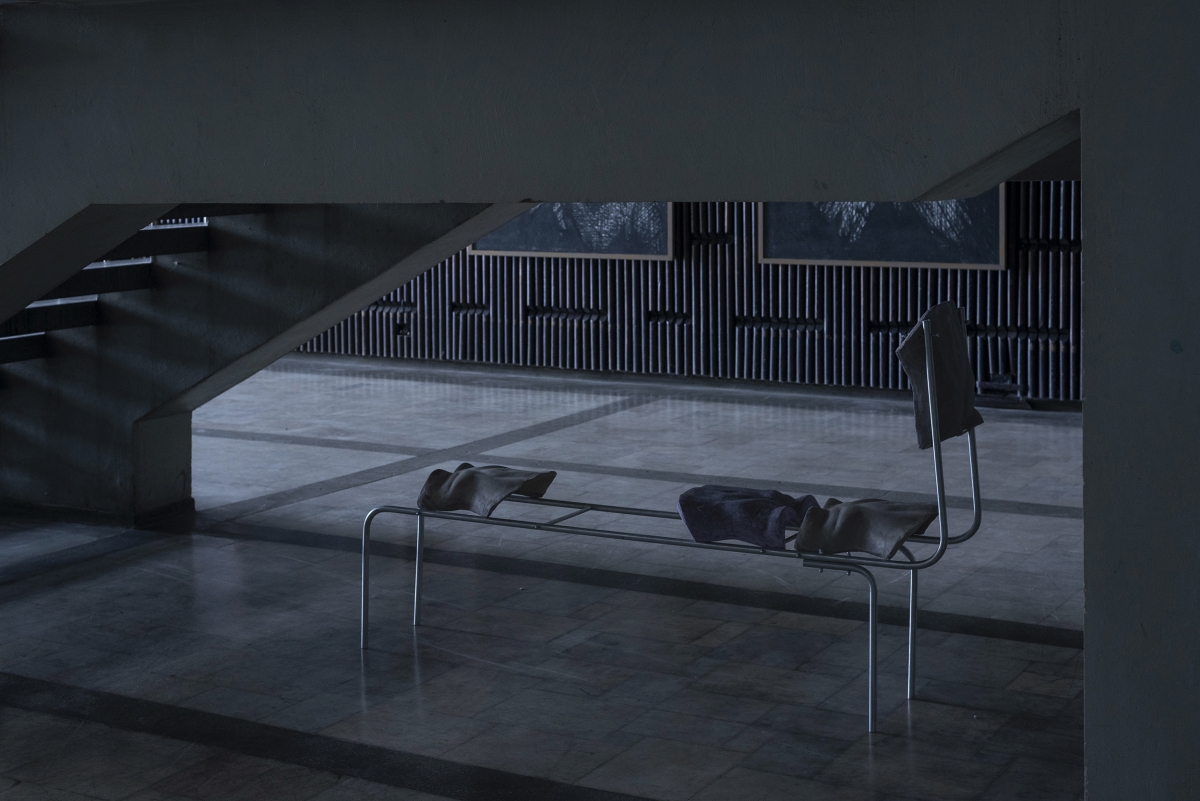
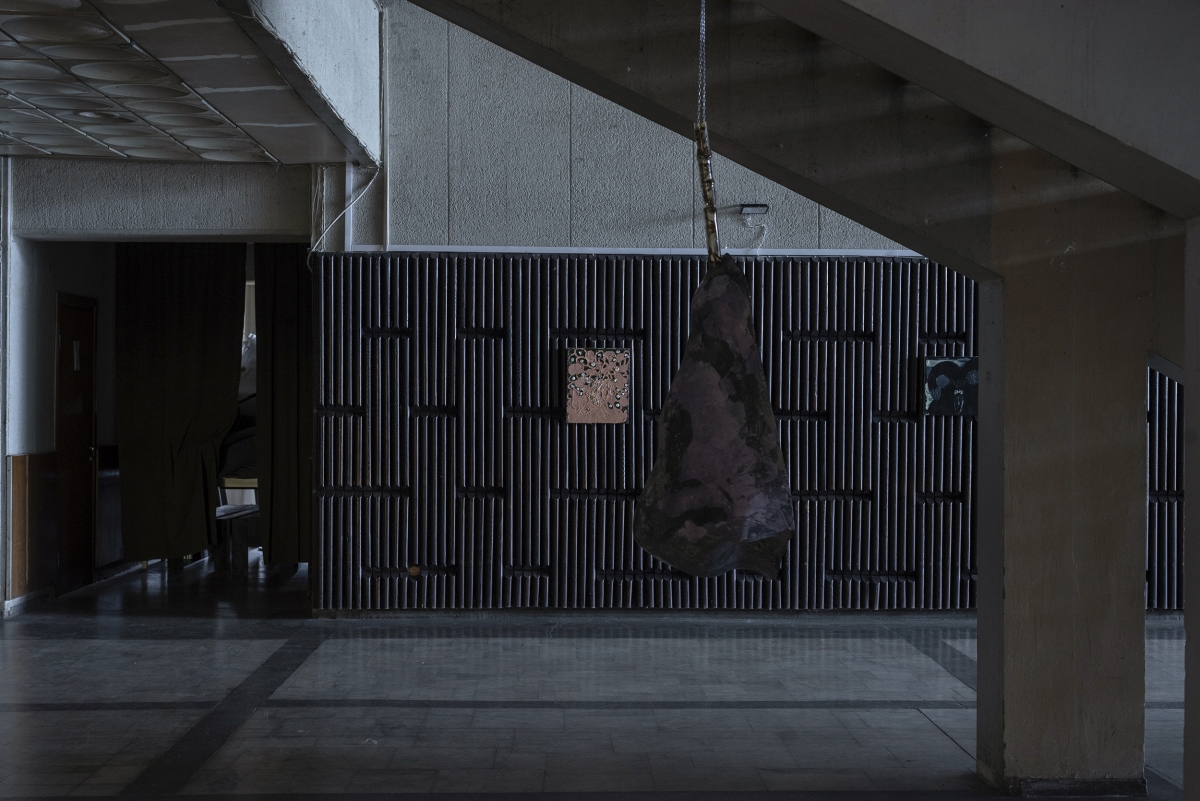
Photo reportage from the exhibition ‘The Uncanny’ at the Palace of Culture, Entertainment and Sport.
[1] In English ‘the uncanny’.
[2] Referenced from the Lithuanian translation of the text (Sigmund Freud, ‘Nejauka’ [translated into Lithuanian by Antanas Gailius], in: XX amžiaus literatūros teorijos: chrestomatija aukštųjų mokyklų studentams. I dalis, Lietuvių literatūros ir tautosakos institutas, 2011, p. 355.)
[3] ‘For instance, we of course attach no importance to the event when we give up a coat and get a cloakroom ticket with the number, say, 62; or when we find that our cabin on board ship is numbered 62. But the impression is altered if two such events, each in itself different, happen close together, if we come across the number 62 several times in a single day, or if we begin to notice that everything which has a number––addresses, hotel-rooms, compartments in railway-trains—always has the same one, or one which at least contains the same figures. We do feel this to be “uncanny”, and unless a man is utterly hardened and proof against the lure of superstition he will be tempted to ascribe a secret meaning to this obstinate recurrence of a number, taking it, perhaps, as an indication of the span of life allotted to him.’ Sigmund Freud, ‘The Uncanny’, first published in Imago, Bd. V., 1919; reprinted in Sammlung, Fünfte Folge (translated by Alix Strachey). Accessed on 2022-10-25 at https://web.mit.edu/allanmc/www/freud1.pdf
[4] From the catalogue of the exhibition ‘The Uncanny’.
[5] Vytautė Auškalnytė, MA thesis ‘Interiors of Vilnius City Public Buildings of the Soviet Period’, 2012, Vytautas Magnus University, p. 27.
[6] From the catalogue of the exhibition ‘The Uncanny’.
[7] Superbia, pride; avaritia, greed; luxuria, lust; invidia, envy; gula, gluttony; ira, wrath; acedia, vainglory.
[8] E.H. Gombrich, Art and Illusion.
